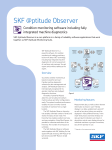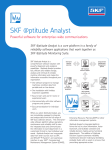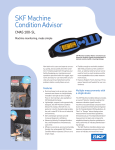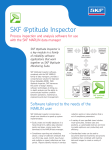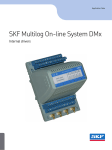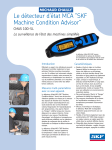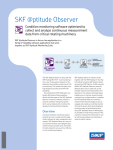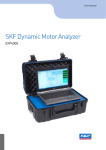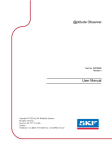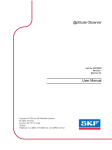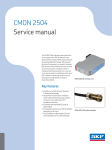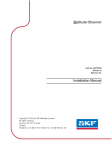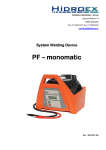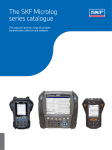Download SKF @ptitude Observer - SKF Maintenance Services
Transcript
SKF @ptitude Observer Expert guided software and intelligent machine diagnostics SKF @ptitude Observer is a core platform in a family of reliability software applications that work together as SKF @ptitude Monitoring Suite. SKF @ptitude Observer is an expertguided software and intelligent machine diagnostics for correct assessment of machines and processes. You get expert advice without talking to the expert. Enterprise resource planning Computerized Maintenance Management System SKF @ptitude decision support Overview Successful condition monitoring is based on powerful and user-friendly machine diagnostics software for data management and analysis. @ptitude Observer is internationally recognized for its operator interface and intelligent diagnostics functions. On-line surveillance/ protection New machines can easily be created in the software by using the Expert Guide. Frequency bands, resolution, defect frequencies, machine diagnosis set up, etc., are generated automatically. The SKF @ptitude Observer software works together with SKF Multilog On-line System IMx, MasCon 48 (all versions), MasCon 16 (all versions) and PerCon. Periodic vibration/ process data SKF @ptitude monitoring suite SKF @ptitude Analyst SKF @ptitude Observer SKF @ptitude Inspector Monitoring features displayed in many different formats. In the Process Overview window, live data and alarm indications are shown in descriptive pictures for individual machines or a group of machines. Measurement data, as well as other relevant information is shown in user-friendly displays. Live data, updated every second, as well as long term history can easily be In the System Overview, the status of each of the system components is shown, clearly displaying any system component malfunction. SKF @ptitude Observer Expert guided software and intelligent machine diagnostics www.skf.com/cm 2 Historical data is shown in powerful trends, where one or more parameters can automatically be displayed and compared to time, such as RPM or process parameters (power, temperature, water level, etc.). Trends can also be live updated every second. Machine information database Mechanical data for each machine monitored is stored in a machine information database. Machine components are connected to each other by dragging and dropping components such as shafts, bearings, gear wheels and impellers, in order to build the machine. For each component, relevant information such as bearing code, number of gear teeth and number of vanes, is stored. Example of a SKF @ptitude Observer orbit. Based on this information and the actual shaft speed, all defect frequencies are Orbit diagram automatically calculated, and advanced diagnostic rules are applied. Using signals from two perpendicularly mounted transducers, the shaft orbital movement can be animated. Orbits can be performed using the raw signal as well as filtered at a user defined frequency range. Root cause analysis Although some of the measurement devices are equipped with automated advanced diagnosis, the software contains a great variety of tools for advanced root cause analysis, for example: Defect frequency display Each machine part, and the interaction between parts, is defined in the machine information database. Based on this information all machine defect frequencies are automatically calculated and can be easily displayed in the frequency spectra by the user. In spectrum live mode the defect frequencies are continuously updated based on the instant shaft speed. Digital Peak Enveloping (DPE) analysis Digital Peak Enveloping represents a major advancement in early detection of bearing faults and is superior to previous techniques for bearing fault detection. RMS-value This is automatically displayed for each spectrum. Trend/bode Vibration amplitude/phase can be trended as a function of time, speed or any process parameter recorded. It is possible to trend discrete frequencies (fixed or speed following) with user selected number of harmonics, as well as a user selected frequency range. Machine diagnostic Includes standard rules for the most common faults such as unbalance, misalignment, various bearing faults, gear faults, cavitation, etc. User defined diagnosis rules can easily be designed. Machine diagnostic is automatically activated by an alarm measurement. SKF @ptitude Observer automatically performs frequency analysis and verifies type of machine fault. Historical comparison of data Frequency spectra taken at different times can be displayed and individually compared. Also subtraction of a selectable measurement can be done. Selected reference spectra may be fixed and automatically matched with new or earlier measurements. SKF @ptitude Observer Expert guided software and intelligent machine diagnostics www.skf.com/cm 3 Polar plot Illustrates phase vs. amplitude including alarm circles. Alarms are set for changes in phase or amplitude outside preset limits. Shaft centerline Using signals from two perpendicularly mounted transducers, the shaft radial position is shown. The system allows sensor mounting in any radial direction with the two sensors 70 to 110 degrees apart. Run-up/coast-down (transient) analysis Example of a SKF @ptitude Observer process overview. Harmonic analysis With a user-defined frequency, harmonic frequencies can be displayed. The system automatically calculates the best fit for the harmonics, making harmonic effects much more visible. This is often used together with defect frequencies. Sideband analysis With a user defined frequency band, sideband frequencies can be displayed making sideband effects much more visible. This is often used together with defect frequencies. Turbine module A fully integrated plug-in module to the SKF @ptitude Observer software is available that detects eccentricity change in coupling; blade failure; bearing instability; steam whirl; rotor crack; rotor rubbing; temporary rotor bow; loose bearing pedestal; inclined position of bearing; electrical run-out; mechanical run-out; loose stator core in generator; change of imbalance at shutdown; radial bearing damage; interturn short circuit in generator rotor, etc. 3-D plot A powerful tool that illustrates frequency spectra vs. speed or time during run-up/coast-down. 3-D plot can be used with any historical data. Turbine run-up or coast-down is automatically detected and a user defined measurement procedure starts. Measurements are taken at defined speed changes and all data is stored in a runup/coast-down buffer. The data can be viewed in a great variety of displays such as 3-D, spectra, time waveform, bode, polar, orbit and shaft centerline. Alarms and warnings There are two types of alarms – primary alarms (checked typically every second) and secondary alarms (checked at every event and at an interval selected by the user, typically once a day). Primary alarms are to detect DC measurement points for both high and low alarms with two levels each. For DPE and vibration measurement points, primary alarms perform at four different frequencies, fixed or speed dependent and one frequency range. All measurement values can be exponentially averaged. Alarm conditions can be controlled by speed and/or load. Secondary alarms are performed by advanced machine diagnostics, with sophisticated alarm conditions chosen from an alarm condition library or created by the operator. Secondary alarms make prognostics three months ahead. If a primary alarm is triggered, secondary alarm diagnostics are automatically performed. For vibration measurements, both primary alarms and secondary alarms can be calculated in acceleration, velocity or displacement, regardless of sensor type. SKF @ptitude Observer Expert guided software and intelligent machine diagnostics www.skf.com/cm 4 All alarms are transferred to the SKF @ptitude Observer Monitor and stored in the database together with corresponding measurement data. The @ptitude Observer Monitor computer can be equipped with relay cards containing 16 relays each, fully programmable to show any type of alarm. Storage The SKF @ptitude Observer software has the capability to store the evaluated data in a Microsoft SQL Server™ or an Oracle® database. Using the royalty free Microsoft SQL Server Express or Oracle Express, the database size can be up to four gigabytes. Using a full version of Microsoft SQL Server or Oracle, the size is almost unlimited. All stored data is marked with identification stating date and time for later use in troubleshooting and trend analysis. To study faults accurately and for correction purposes, it may also be beneficial to store other information than vibration values, e.g., active and reactive power (standard). Storing of turbine guide vane position, water level, voltage, temperature, etc. are optional. Storage is made in the following form: Trend storage Saves evaluated data. The trend data consists of different trend buffers storing data from once every 10 seconds to once every week. A value from the first trend buffer is also stored in the archive buffer every tenth minute. All trend buffers and the archive buffer are using FIFO (first-in, first-out). Spectra storage At a user defined time interval and upon an event (see below) vibration spectra are stored for each of the following measurement points: • vibration • vibration, harmonic • DPE • process FFT SKF @ptitude Observer Expert guided software and intelligent machine diagnostics www.skf.com/cm 5 Event related storage Measurement points can be grouped. When an event occurs, based on data from one of the group members, measurement data from all group members is stored. Also, an alarm is generated in the alarm list showing what evaluation form caused the event. An event can be an alarm or a change in process data. Remote control Since SKF @ptitude Observer is a full client/ server application, commercial remote products can be used. The SKF @ptitude Observer Monitor can be connected to the Internet through a firewall and easily accessed from a Windowsbased computer anywhere having SKF @ptitude Observer installed. Also remote control products like Citrix®, pcAnywhere™, Remote Desktop®, etc. are compatible. Data communication using OPC SKF @ptitude Observer can be connected to other systems or devices through an OPC server using the OPC standard communication protocol. Data transmission (data publication) of trend data and alarm information, as well as data reception (data subscription) of process data is possible. System integrity An on-line condition monitoring system should always be operating. If something happens that interrupts the monitoring, the system must be able to detect the fault and report it to the operator. If possible the system itself should be able to correct the fault and continue to operate. Below is a description of the @ptitude Observer system integrity: • checks all sensor signals and report on failure • a Watchdog looks after both the IMx/MasCon units and the @ptitude Observer Monitor and reports, then restarts upon failure • easy for the operator to disable a measurement point upon sensor failure • system faults are stored in the database and can be accessed by the operator, for example, during system service SKF @ptitude Observer Expert guided software and intelligent machine diagnostics www.skf.com/cm 6 SKF @ptitude Observer features and capabilities ALARMS • Alarm window – Quickly find and identify all points in alarm within the hierarchy, process view, system view, diagram view or machine view • Alarm details – Provides a summary of type of alarm and status • Trend alarms – Trend alarms frequency can be fixed or speed following with a selectable number of harmonics – The trend alarm level can be speed or process data dependent following a user defined graph – Unlimited number of alarms can be configured in the system – Alarms based on data from multiple measurement points – Run-up/coast down alarming using speed dependent alarm levels – Vector alarms using circular alarm levels in polar plane – Alarm hysteresis – Exponential filtering – Activation of user selectable on-line device relay for each alarm level violation – Activation of user selectable @ptitude Observer Monitor device relay for each alarm level violation – User defined vibration unit selection (acceleration, velocity or displacement) – Data storage selection (maximum, minimum or instant) – Alarm blocking (on/off) – Alarm groups • Four overall alarm levels per measurement point – Danger high, alert high, alert low, danger low – Adaptive alarming whereas the trend alarm level can be speed or process data dependent following a user defined graph – Enhanced event log capabilities • Machine Diagnostics – Alarms based on rules created to detect a particular machine fault – Standard rules as well as user defined rules available – Clear text message on machine fault • Active range – Speed range setting and/or Process data range setting – Setting for maximum allowed speed and/or process data variation during measurement – Advanced Data Gating COMMUNICATION • Automatic e-mail or SMS generation upon alarm • Data transfer with SKF IMx, MasCon and PerCon. For other devices contact your local SKF Representative. • TCP/IP • Download by Hierarchy or Route • OPC - subscription as well as publication • Modbus MACHINE PARTS • Graphical tool for machine library creation • Automatic defect frequency calculation • Automatic calculation of all shaft speeds • Seamless connection to Machine Diagnostics • Standard library • Machine template DATA DISPLAY All displays can be used in live mode for transient as well as for steady-state analysis • • • • • • • • • • • • • • • • • • Orbit Shaft centerline Polar (including circular alarm levels) Bode Profile Airgap Overall trend displays Process (Temperature, pressure, speed, etc.) Digital images Spectrum displays Single point, multiple point displays Triaxial point Time waveform displays – Single point, multiple points Multi-channel display Process overview – Live update – Amplitude/phase – Speed – Links to other process views – Live bars Graph overlays Spectrum – Machine part defect frequency – Single, harmonic, sideband, peak, band cursors – Running speed – Spectral band alarm – Overall alarms – DiagX Display tools – Notes with image attachment capability – Reviews with Priority Setting – Percent of alarm level setting – Auto scaling – Cursor micro-manipulation – Autolinking of displays and active hierarchy – Linear or log scaling – Grid – Orders, frequency scaling – Amplitude threshold % – Waterfall slant angle setting in all directions – Date range setting – User selectable color settings – Waterfall spacing (time/date, speed or process data) – Spectrum data post processing (integration/differentiation) – Zero Padding – Inverse FFT – Baseline spectrum storage – Run-out compensation DATABASE • Built on Microsoft SQL Server 2005 • Microsoft SQL Server 2000 compatible • Oracle® 9i and 10g compatible • ODBC, SQL, and TCP/IP protocol compliant database opens the database content • User friendly database management – Back-up scheduling – Database upgrade • Fully networkable in a Local Area Network (LAN), Wide Area Network (WAN), and Thin-client (Terminal) environments • Unlimited number of: – hierarchies – collection points – measurements • Smart Data Storage – Data storage based on time, speed variation, process data variation, alarm status and trend variation – Capability of data reduction due to aging • Database supports – XML data importing and exporting – Binary importing and exporting – Data export to Image file, Text, XML, HTML, Microsoft Excel® GENERAL • Multiple languages available • Windows®-based functionality – True multi-processing operating environment allowing simultaneous background and foreground processing – Complete right click functionality (drop down menus) – Drag and drop – Cut/Copy/Paste – Complete integration of third party applications • User preferences allow customization • Context sensitive help • Complete user manual on installation CD-ROM • Product Support Plans (PSP) available MEASUREMENTS The following measurements can be entered manually or automatically • • • • • • • • • • • • • • • • • • • • • • • Acceleration Amps Displacement English or metric units Enveloped acceleration Flow (GPM, LPM) High Frequency Detection (HFD) and Digital High Frequency Detection (DHFD) Inspection points (user definable) Multi-channel Operating hours Operating time (elapsed and cumulative) Pressure (PSI and bars) RPM SKF acceleration enveloping (gE) Speed Temperature (°C and °F) Triax User-specific units Velocity Volts (AC or DC) Torsion Time difference Simultaneous speed, process and digital storage together with vibration, speed or process measurement • Derived Point – user definable mathematical formula to calculate a derived value from data collected on multiple points across all type of devices. TRANSIENT ANALYSIS • Run-up/coast down measurements • Run-up/coast down measurement point groups • Adaptive alarming • Run-out compensation • Live data display update for multiple graphs REPORTS • Preserved reports – enables you to maintain a history of reports. • Shared reports – allows you to share and preconfigure reports for selected users. • Send reports to screen, PDF file, printer • PDF file can be posted to internet, intranet, e-mailed • Customizable report content • Data plots, supplemental information, and digital images can be included in reports • Report types – Last measurement – Exception – Collection status – History – Inspection – Work notification – Blank (user defined) • Report templates allow quick and easy report configuration for use and reuse SECURITY • Fully configurable user rights that allow you to read, view and have full access MONITORING SYSTEM SUPERVISION • BOV range setting and alarm upon failure • Measurement range setting and alarm upon failure • @ptitude Observer Monitor supervision • On-line device supervision (automatic hardware reset) • System supervision alarm distribution using e-mail and SMS • On-line device and @ptitude Observer Monitor device restart upon failure • Automatic remote firmaware upgrade of all on-line devices (MasCon, IMx) • System event recording for all parameter modifications including date/time and user information TEMPLATES AND WIZARDS • Machine parts creation wizard • Multiple point update wizard • Statistical alarm wizards use historical data to help refine machine diagnostic alarms • Hierarchy template wizard allows for rapid hierarchy creation and machine templates for reuse • Report template allows for the custom configuration of reports and report templates for reuse • Machine Expert Wizard SKF @ptitude Observer Expert guided software and intelligent machine diagnostics www.skf.com/cm 7 Hardware requirements STAND ALONE CONFIGURATION • Running SKF @ptitude Observer • Running Oracle® or Microsoft SQL database management system • Storing data Operating system Minimum Requirements Recommended Requirements Windows 2000 with Service Pack 4, Windows XP Professional with Service Pack 2, Windows 2003 Server with Service Pack 1 OR Windows Vista Processor (* Note 1) Pentium IV, 1.0 GHz Pentium IV, 2.4 GHz or better RAM 512 MB 1.0 GB or more Disk space available for stand alone computer (* Note 2) 1.2 GB 1.2 GB or more CD/DVD drive One (1) required One (1) required Video display 800 x 600 1024 x 768 or larger Minimum Requirements Recommended Requirements Network configuration – SERVER • Running Oracle® or Microsoft SQL database management system • Storing data Operating system Windows 2003 Server with Service Pack 1, Windows 2000 Server with Service Pack 4 OR Windows Vista Processor (* Note 1) Pentium IV, 2.0 GHz Pentium IV, 3.2 GHz RAM 1.0 GB 2.0 GB or more Disk space available (* Note 3) 1.2 GB 1.2 GB or more Oracle /Microsoft SQL Version 9i, 10g/SQL Server 2000, 2005 ® Network configuration – NETWORK CLIENT • Running SKF @ptitude Observer • Running database client software Operating system Minimum Requirements Recommended Requirements Windows 2000 with Service Pack 3+ OR Windows XP Professional with Service Pack 2 OR Windows Vista Processor (* Note 1) Pentium IV, 1.0 GHz Pentium IV, 2.4 GHz RAM 512 MB 1.0 GB or more Disk space available for each network client (* Note 2) 200 MB 500 MB or more CD/DVD drive One (1) required One (1) required Video display 800 x 600 1024 x 768 or larger Oracle®/Microsoft SQL Version 9i, 10g/SQL Server 2000, 2005 NOTE 1: These requirements apply to SKF @ptitude Observer complete with database manager. Other applications running simultaneously may degrade performance. NOTE 2: These requirements ONLY apply to SKF @ptitude Observer complete with database manager. Additional storage disk space is required for data. NOTICE: If running other versions of Oracle, Microsoft SQL Server, or other database engines are expected to run in the same PC environment, please contact your local SKF Representative to inquire about compatibility. SKF @ptitude Observer – Expert guided software and intelligent machine diagnostics Ordering information • SKF @ptitude Observer software for SKF Multilog On-line System IMx (all versions), MasCon 48 (all versions), MasCon 16 (all versions) and PerCon [CMSW 7500] The SKF @ptitude Observer is available in Single and Multiple Client configurations. Please contact your local SKF Reliability Systems representative for Multiple Client model information. Product Support Plans (PSP) A range of Product Support Plans are available to protect your investment. Contact your local SKF Reliability Systems Sales Representative for additional information. Installation and training Installation and training available through your local SKF Supplier or Representative. SKF Reliability Systems SKF Condition Monitoring Center – Luleå Aurorum 30, S-977 75 • Luleå, Sweden Telephone: +46 (0) 920 758 00 • FAX: +46 (0) 920 134 40 Web Site: www.skf.com/cm The contents of this publication are the copyright of the publisher and may not be reproduced (even extracts) unless permission is granted. Every care has been taken to ensure the accuracy of the information contained in this publication but no liability can be accepted for any loss or damage whether direct, indirect or consequential arising out of the use of the information contained herein. SKF reserves the right to alter any part of this publication without prior notice. SKF Patents include: #US05854553, #US05845230, #US06489884, #US05679900, #US04768380, #US06199422, #US05992237, #US06202491, #US06513386, #US06275781, #US06633822, #US06006164, #US2003_0178515A1, #US6,789,025, #US6,789,360, US 5,633,811 and US 5,870,699, #WO_03_048714A1 • SKF, @ptitude, MasCon, Multilog, Microlog and MARLIN are registered trademarks of the SKF Group. • Microsoft, Windows and Remote Desktop are registered trademarks and SQL Server is a trademark of Microsoft Corporation. • Oracle is registered trademark of Oracle Corporation. • Citrix is a trademark of Citrix Systems, Inc. and/or one or more of its subsidiaries, and may be registered in the United States Patent and Trademark Office and in other countries. • pcAnywhere is a trademark of Symantec Corporation. • All other trademarks are the property of their respective owners. CM2369 (5-07) • Copyright © 2007 by the SKF Group. ALL RIGHTS RESERVED.








